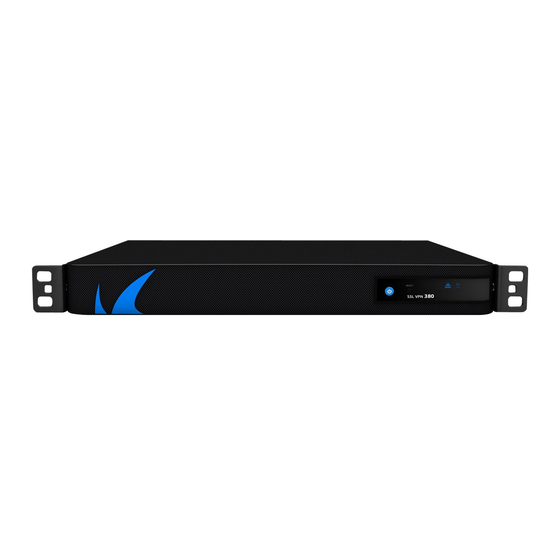
Advertisement
Quick Links
The Barracuda SSL VPN provides remote users secure, clientless access to your internal network. The Barracuda SSL VPN
may be installed directly inside the LAN or in a more complex DMZ configuration. Follow the instructions in this guide
to configure the Barracuda SSL VPN to accept incoming connections from the Internet.
1
Getting Started
To begin setting up your Barracuda SSL VPN, you will need the following:
• Barracuda SSL VPN appliance
• AC power cord; AC input voltage range is 100-240 volts at 50/60 Hz
• Ethernet cables
• VGA monitor (recommended)
• PS2 keyboard (recommended)
2
Physical Installation
1. Install the Barracuda SSL VPN to a 19-inch rack or place it in a stable location.
2. Connect an Ethernet cable from your network switch to the Ethernet port on the back of the Barracuda SSL VPN.
3. Connect a VGA monitor, PS2 keyboard, and the AC power cord to the unit.
4. Turn on the unit by pressing the power button on the front panel.
3
Configure IP Address and Network Settings
With a monitor and keyboard attached
As soon as the Barracuda SSL VPN is fully booted the administrative console login is displayed:
1. Log into the Administrative Console using the admin credentials:
Login:
admin
Password:
admin
2. Configure the IP Address, Subnet Mask, Default Gateway, Primary DNS Server and
Secondary DNS Server as appropriate for your network.
Without a monitor and keyboard attached
Use the RESET button on the front panel to configure the IP adress. Press and hold the RESET button according to the
table bellow:
IP Address
Netmask
192.168.200.200
255.255.255.0
192.168.1.200
255.255.255.0
10.1.1.200
255.255.255.0
Press and hold RESET for
5 seconds
8 seconds
12 seconds
Barracuda SSL VPN - Quick Start Guide
4
Configure the Firewall
If your Barracuda SSL VPN is located behind a corporate firewall, open the following ports on your external
firewall to ensure proper operation:
Port
Direction
TCP UDP
22
Out
Yes
No
25
Out
Yes
No
53
Out
Yes
Yes
90
Out
Yes
No
123
Out
No
Yes
443
In
Yes
No
8000
Out
Yes
No
Typically the corporate firewall is configured to port forward incoming HTTPS/SSL connections on port 443 directly to
the Barracuda SSL VPN.
Port
Direction
TCP UDP Usage
1723
In
Yes
No
500
In
No
Yes
4500
In
No
No
To use L2TP/IPsec and PPTP in combination with an internal firewall, you must open the following ports:
Port
Direction
TCP UDP Usage
389
Out
Yes
No
636
Out
Yes
No
5
Log into the Appliance Web Interface
Use a computer with a web browser that is connected to the same network as the Barracuda SSL VPN, to
log into the web interface:
1. Enter http://IP address of the Barracuda SSL VPN:default appliance web interface HTTP port
in your browser. For example, if you configured the Barracuda SSL VPN with an IP address of 192.168.200.200, you
would type:
http://192.168.200.200:8000
2. Log into the appliance web interface as the administrator: Login: admin , Password: admin
Usage
Remote diagnostics and service (recommended)
Email alerts + One-time passwords
Domain Name Service (DNS)
Firmware and definition updates
Network Time Protocol (NTP)
HTTPS/SSL port for SSL VPN access
Firmware and definition updates (backup)
PPTP access (
PPTP access also requires GRE (IP protocol 47))
L2TP/IPsec access
L2TP/IPsec access
LDAP/Active Directory read access
LDAP/Active Directory read/write access
Advertisement

Summary of Contents for Barracuda SSL VPN
-
Page 1: Configure The Firewall
HTTPS/SSL port for SSL VPN access 1. Install the Barracuda SSL VPN to a 19-inch rack or place it in a stable location. 2. Connect an Ethernet cable from your network switch to the Ethernet port on the back of the Barracuda SSL VPN. 8000 Firmware and definition updates (backup) 3. -
Page 2: Next Steps
Barracuda Networks, Inc. 3175 S. Winchester Blvd, Campbell, CA 95008 USA • phone: 408.342.5400 • fax: 408.342.1061 • www.barracuda.com Copyright 2004-2013 • Barracuda Networks, Inc. All rights reserved. Use of this product and this manual is subject to license.














Need help?
Do you have a question about the SSL VPN and is the answer not in the manual?
Questions and answers